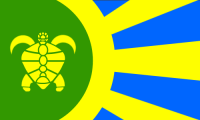Motu Motiro Hiva
| This page was copied from http://karnell.weebly.com/colonies.html and serves primarily as a notebook for it. |

| |
| Languages: | |
| Official: | Arero Henua |
| Others: | Japanese |
| Area: | 37 acres |
| Established: | 1878, Henua sovereignty established by treaty |
| Population: | 4 convicts |
| King: | Ña'ara (Nga'ara) III |
| Subdivision of: | Henua |
(Manu) Motu Motiro Hiva is a tiny island 260 miles to the east of Henua, or Easter Island. The name means "(Bird's) Island on the Way to Far-Off Lands" in the Arero Henua language. The "far-off land" is the South American coast, to which the Henua have made sporadic voyages since early times. The Spanish name, Isla Sala y Gomez, is named after two explorers who charted the island in 1805.
Motu Motiro Hiva is the only secondary island within the territory of the Henua kingdom. It consists of two rocky lobes, altogether only 1000 feet long at low tide, a mere 250 feet at high tide. It is much too small to support a permanent population, but is an important traditional hunting and fishing area for the Henua people. At certain times in the year, the island overflows with birds, but many bird species have avoided Henua proper since the human population rose in the twelfth or thirteenth centuries.
The Henua continue to make one ritual race to Motu Motiro Hiva in early summer by traditional outrigger canoe. The kingdom's seven mata, or clans, each sponsor one ship to compete. The king normally goes along, sailing with his own clan. The opening of the race is a major event, one of the chief festivals of the summer. Henua hunters and fishermen make several other trips in motorized boats throughout the summer. The islet is also used for a small penal colony for permanent or temporary exiles.
Read more at http://www.geocities.com/henua_home/colony.html.
